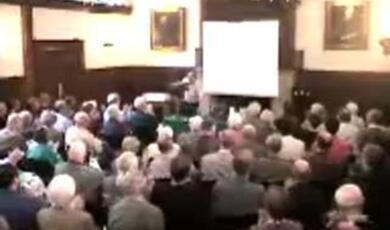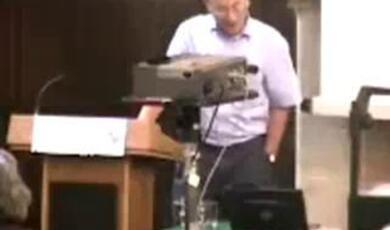The Rosetta Mission
Share
- Details
- Transcript
- Audio
- Downloads
- Extra Reading
The European Space Agency’s Rosetta probe and its Philae lander are key to furthering our understanding of the formation of our solar system, and the origins of life. Matt Taylor, the Project Scientist for the ESA mission, offers an introduction to the first ever soft landing on a comet and how it is opening a new chapter in Solar System exploration.
Download Transcript
26 February 2015
The Rosetta Mission
Dr Matt Taylor
The Rosetta Mission is the third cornerstone mission of the ESA programme Horizon 2000. The aim of the mission is to map the comet 67-P/Churyumov-Gerasimenko by remote sensing, to examine its environment insitu and its evolution in the inner solar system. The lander Philae is the first device to land on a comet and perform in-situ science on the surface. Launched in March 2004 and after a number of gravity assists and various asteroid fly –bys, the spacecraft entered deep space hibernation in June 2011. Nearly 10 years after launch on 20th January 2014 at 10:00 UTC the spacecraft woke up from hibernation, and subsequently successfully entered into orbit around the comet and deployed Philae to the surface.
The Rosetta mission is set to re-write the books on cometary science, giving us an unprecedented insight into how these bodies are connected to the origins of the solar system and how it evolved to how we know it today.
Rosetta is the European Space Agency’s comet-chasing mission to 67P/Churyumov-Gerasimenko. Launched on 2 March 2004 the spacecraft travelled for 10 years before homing in on its destination, requiring three vital gravity assist flybys at Earth and one at Mars to set course with the comet. Rosetta is the first spacecraft to rendezvous with a comet and the first to deploy a lander on the surface of a comet nucleus. While previous comet missions have only spent fleeting moments flying past their targets at high velocity, Rosetta ia the first spacecraft to fly alongside a comet as it heads towards the inner Solar System, watching how its ices are transformed by the warmth of the Sun. Rosetta will then continue to follow the comet for several months beyond its closest approach to the Sun, watching how the comet’s activity subsides again.
The Rosetta mission was named after the famous Rosetta stone thatalmost 200 years ago,led to the deciphering of Egyptian hieroglyphics. Rosetta’s lander Philae is named for the island in the River Nile on which an obelisk was found that had a bilingual inscription that enabled the hieroglyphs of the Rosetta Stone to be deciphered. Scientists hope that by studying a comet close up and for an extended period of time, the comet-chasing spacecraft by the same name will unlock the mysteries of how the Solar System evolved.
Comets are considered the most primitive building blocks of our cosmic neighbourhood, surviving the Solar System’s chaotic 4.6 billion year history. Laced with ice and organic materials, cometsprobablyhelped ‘seed’ the Earth with water, and maybe even the ingredients for life. As such, comets are considered the Rosetta Stones of the Solar System, and ESA’s Rosetta mission is set to unlock the secrets of these icy treasure chests.
Rosetta’s mission has its roots buried in the legacy of “Giotto”, ESA’s first deep space mission, which sent back the closest images ever of a comet nucleus, from a distance of about 600 km. Despite taking heavy hits from comet dust, Giotto went on to fly by Grigg-Skjellerup in 1992. As such, Giotto was also the first deep-space mission to change orbit by retuning to Earth for a gravity-assist manoeuvre.
After a 14-month launch delay that led to the mission’s destination being changed from comet 46P/Wirtanen to 67P/Churyumov-Gerasimenko, Rosetta finally launched on 2 March 2004 on an Ariane-5 G+ from Europe’s spaceport in Kourou, French Guiana.
Comet 67P/Churyumov-Gerasimenko is a regular visitor to the inner Solar System. It orbits the Sun once every 6.5 years, commuting between the orbits of Jupiter and Earth – its closest distance to the Sun is 185 million kilometres (by comparison, Earth is about 150 million kilometres from the Sun). The comet was first observed from Earth in 1969 – Klim Churyumov discovered the comet in a photograph taken by Svetlana Gerasimenko, giving rise to its name. The 67P indicates that it was the 67th short period (P) comet discovered.
To get to this target, Rosetta exploited the gravity of Earth and Mars to set course with the comet. Thus for the first half of its journey Rosetta played a game of cosmic pinball, first getting a boost from Earth’s gravity on 4 March 2005, then Mars on 25 February 2007, before bouncing back to Earth on 13 November 2007 and again in 13 November 2009. Along the way, Rosetta delved twice into the Solar System’s asteroid belt, taking the opportunity to return spectacular close-up images and perform scientific analysis of two previously uncharted bodies: asteroid 2867 Steins on 5 September 2008, and 21 Lutetia on 10 July 2010.
Rosetta travelled far away from the Sun, such that solar energy was not enough to support the platform completely and entered into hibernation on 8 June 2011 for the coldest leg of its journey as it headed towards the orbit of Jupiter. All systems were switched off except for the thermal control and onboard computer, powered only by the solar panels. On 20 January 2014, 957 days later, the spacecraft autonomously woke up from hibernation, 9 millionkilometres from the comet. The next months were spent closing in on the comet, eventually entering a 10 km orbit and mapping it for landing. On 12 November 2014, Rosetta deployed Philae to the surface. The Philaesuccessfully landed, bounced,and finally came to rest on the surface around 1 km from the original landing site.
The Rosetta mission is set to re-write the books on Cometary science. Currently funded until end of 2015, we hope to extend the mission into 2016, until the spacecraft and comet move away from the Sun so that power becomes an issue again.
© Dr Matt Taylor, 2015
This event was on Thu, 26 Feb 2015
Support Gresham
Gresham College has offered an outstanding education to the public free of charge for over 400 years. Today, Gresham plays an important role in fostering a love of learning and a greater understanding of ourselves and the world around us. Your donation will help to widen our reach and to broaden our audience, allowing more people to benefit from a high-quality education from some of the brightest minds.


 Login
Login







